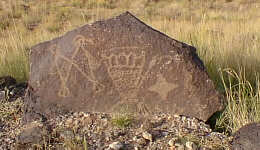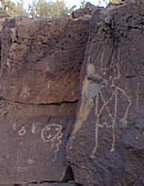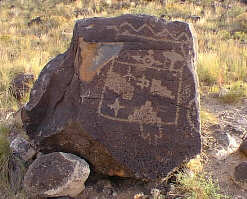 The
valley and mesa lands surrounding Albuquerque have been inhabited by people
for the past 12,000 years. Nomadic Paleo-Indian and archaic hunters, ancestors
of contemporary pueblo-dwelling American Indians, then the early Spanish colonists,
and finally Anglo-American settlers have all left behind physical remains of
their daily lives as archaeological sites.
The
valley and mesa lands surrounding Albuquerque have been inhabited by people
for the past 12,000 years. Nomadic Paleo-Indian and archaic hunters, ancestors
of contemporary pueblo-dwelling American Indians, then the early Spanish colonists,
and finally Anglo-American settlers have all left behind physical remains of
their daily lives as archaeological sites.
Archaeological sites are nonrenewable resources; they provide the only available source of information on the people and civilizations that flourished in the middle Rio Grande Valley long ago. To the professional and amateur archaeologists trained in site identification and interpretation, these sites provide the key to understanding how human beings have interacted with Albuquerque's environment over thousands of years. Archaeological sites provide information that augments the area's sketchy, 400-year-old, written historic record; acts as a foundation for interpretive museum exhibits and educational program;, and provides a potential focus for recreational and tourist-related activities.
The Albuquerque area has archaeological sites of major state and national importance. The rock art (petroglyph) sites on the volcanic escarpment west of Albuquerque provide the most spectacular example of this type of cultural resource to be found within an urban area. This is one of the largest concentrations of prehistoric American Indian rock art sites in the United States. Other areas of the west mesa are among those few areas in New Mexico where Paleo-Indian sites may be found dating back 12,000 years. Other sites within the urban area include some of the earliest agricultural villages in the U.S. and late prehistoric pueblo villages dating back 300 to 900 years--some may have had as many as 1500 rooms. Historic sites from every period in Albuquerque's development lie buried beneath river silt on the valley floor and residential areas of Albuquerque. Over 1600 sites in Bernalillo County have been formally reported to the state Laboratory of Anthropology in Santa Fe--and many more sites are known to exist or have not yet been found.
Surface collections of artifacts been made at less than half of the reported sites and very few of these sites have been excavated. Anthropologists and archaeologists estimate that over 60% of the archaeological sites in the Albuquerque area have been destroyed during the past forty years. As the city continues to develop, additional sites important to our heritage will be lost forever. Other problems plague these resources. Vandalism by ignorant or unthinking individuals continues to occur to west mesa petroglyph sites even though they are in a national monument. "Pot hunting" on public and private land is an ongoing concern.
 |
Mitigation of impact on archaeological sites is required for projects that are federally funded or licensed and for projects occurring on state lands. But the strongest impact on archaeological resources occurs at the local level with planning and land-use decisions; this is also where public and private preservation efforts reap the greatest benefits. The 1975 Albuquerque/Bernalillo County Comprehensive Plan, revised in 1988, provides policy guidelines for the preservation of historic and cultural properties including archaeological sites. In 1978, the Albuquerque city council enacted two ordinances that provided procedures for the designation of local landmarks and Historic Overlay Zones and created the Landmarks and Urban Conservation Commission. While these local laws included archaeological sites as areas to be landmarked, no program for identifying and assessing local archaeological sites was established. The 1983-84 Albuquerque Goals Committee expressed the need for strengthening and implementing current ordinances and policies. In response to growing concern over the future of Albuquerque's archaeological resources, the city council and the county commission created the joint Albuquerque/ Bernalillo County Archaeological Resources Planning Advisory Committee in 1984. The committee was responsible for exploring issues and needs regarding archaeological resources, establishing goals, and proposing a viable range of planning and management alternatives. Despite this progress, a city/county archaeological protection ordinance has remained in an unadopted draft form for over 10 years.
While archaeological resources are given the same consideration provided for other historic properties under federal, state, and local law, they differ from historic buildings in certain fundamental ways that require different planning and management techniques:
Except where protective measures have been taken, the confidentiality of site locations is required. The indiscriminant release of site information can lead to destruction of the resource by "pot hunters" interested in personal gain from collecting or selling valuable artifacts.
Archaeologists utilize the information provided by artifacts and material remains to answer carefully formulated research questions concerning the life ways of different cultures and the relationships between human beings and their environment. Decisions regarding the significance of sites (which sites to preserve or excavate) are based on these professionally developed research questions and project designs based on what is already known about the culture and resource. Even very significant sites may not require preservation or protection in perpetuity, but only until valuable information can be extracted, freeing the land for other uses and development. By integrating archaeological resource considerations with the planning and development processes, information can be saved without unduly delaying development.
 Over
time, improved scientific techniques and more refined research questions lead
to an increase in what can be learned from the material remains at an archaeological
site. For this reason, the archaeologist often recommends leaving sites undisturbed
wherever feasible, rather than excavating them. When archaeologically sensitive
areas are planned for development, measures can be taken to mitigate impacts
on sites.
Over
time, improved scientific techniques and more refined research questions lead
to an increase in what can be learned from the material remains at an archaeological
site. For this reason, the archaeologist often recommends leaving sites undisturbed
wherever feasible, rather than excavating them. When archaeologically sensitive
areas are planned for development, measures can be taken to mitigate impacts
on sites.
These measures may include surveys of the area, below-ground testing, salvage work, or excavation. A variety of techniques can be employed for acquiring legal rights to sites which have interpretive potential for public use or require long-term protection. These mechanisms include the purchase of easements, open space dedication, transfer of development rights, tax incentives for the donation of the property, or outright purchase. The cost of mitigation and acquisition can be reduced if sites are identified early in the planning process and prior to starting development.
The future of Albuquerque's archaeological resources depends upon the actions taken by educators, archaeologists, public officials, and concerned citizens. There is a real danger that these actions may be too few or come too late to protect what is left of this rapidly disappearing resource. Archaeological resources offer potential economic benefits from tourism and they strengthen Albuquerque's cultural identity as a city with an ancient heritage. More important, they provide us with an understanding of ourselves and our environment.
(Up to Section V, Back to Animals and Plants, On to Architectural Review)